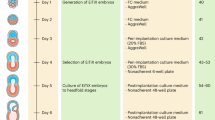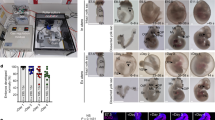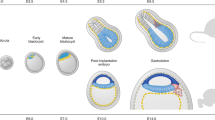Abstract
EXPERIMENTAL embryology in mammals is hampered by the comparative inaccessibility of the mammalian embryo. The development of techniques for the cultivation in vitro of early mammalian embryos has provided one possible route for experimental interference in the course of embryonic development, through alteration in the conditions of culture and the composition of the culture medium. However, a study of the effects of such experimental interference upon later embryonic development also requires the application of techniques for transplanting early embryos to foster mothers. The first successful attempt to combine the techniques of embryo culture and embryo transplantation was briefly reported by Adams1. 16-cell rabbit embryos were incubated for 21½ hr. in Krebs–Ringer bicarbonate containing 2 mgm./ml. bovine plasma albumin, fraction V (Armour), during which time cleavage continued at the normal rate. They were then transferred to a recipient female mated 3 days previously to a vasectomized male. One week later there were normal embryos in the uterus of the recipient female, presumably developed from the cultured embryos.
This is a preview of subscription content, access via your institution
Access options
Subscribe to this journal
Receive 51 print issues and online access
$199.00 per year
only $3.90 per issue
Buy this article
- Purchase on Springer Link
- Instant access to full article PDF
Prices may be subject to local taxes which are calculated during checkout
Similar content being viewed by others
References
Adams, C. E., “Artificial Insemination”, 5, Third International Congress on Animal Reproduction, Cambridge (1956).
Whitten, W. K., Nature, 177, 96 (1956).
Whitten, W. K., J. Endocrinol., 16, 80 (1957).
Runner, M. N., and Palm, J., J. Exp. Zool., 124, 303 (1953).
McLaren, A., and Michie, D., J. Exp. Biol., 33, 394 (1956).
Author information
Authors and Affiliations
Rights and permissions
About this article
Cite this article
McLAREN, A., BIGGERS, J. Successful Development and Birth of Mice cultivated in vitro as Early Embryos. Nature 182, 877–878 (1958). https://doi.org/10.1038/182877a0
Issue Date:
DOI: https://doi.org/10.1038/182877a0
This article is cited by
-
A 3D “sandwich” co-culture system with vascular niche supports mouse embryo development from E3.5 to E7.5 in vitro
Stem Cell Research & Therapy (2023)
-
Truth in science: experimental design and the legacy of John D Biggers, PhD., DSc
Journal of Assisted Reproduction and Genetics (2020)
-
Mouse embryo assay for human in vitro fertilization quality control: a fresh look
Journal of Assisted Reproduction and Genetics (2020)
-
Development of bovine embryos in vitro in coculture with murine mesenchymal stem cells and embryonic fibroblasts
Molecular Biology Reports (2018)
-
High Potassium Concentration during Culturing of Early Mammalian Embryos: Normal or Extreme Situation?
Bulletin of Experimental Biology and Medicine (2017)
Comments
By submitting a comment you agree to abide by our Terms and Community Guidelines. If you find something abusive or that does not comply with our terms or guidelines please flag it as inappropriate.



